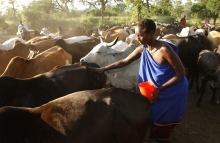Women are main guardians of crucial livestock diversity | ||
New study argues that to succeed, breed conservation efforts must empower women | ||
 Woman with indigenous cattle in East Africa. 5 November 2012, Rome - Women livestock keepers worldwide must be recognized as the major actors in efforts to arrest the decline of indigenous breeds, crucial for rural food security and animal genetics, a new FAO study argues. Yet women's contribution to indigenous livestock breeding and conservation is poorly documented and undervalued, the study Invisible Guardians: Women manage livestock diversity says. Of the 600 million poor livestock keepers in the world, around two-thirds are women, whose men often have migrated to the cities. Women stay at home with the children and live by cultivating crops and keeping indigenous smallstock such as chickens or goats, and perhaps a cow. Indigenous breeds are adapted to often harsh local conditions, are disease resistent, thrive on easy to obtain local fodder or forage and generally take care of themselves. Such breeds may not produce a lot of meat, milk or eggs but they are low maintenance for run-off-their-feet poor rural women. Such breeds are also a repository of irreplaceable genetic material. They often have traits such as disease-resistance that can be important for breeding programmes. And in a world threatened by climate change, breeds that are resistant to drought, extreme heat or tropical diseases are of major potential importance. Problems may arise when projects or national authorities try to introduce exotic breeds or cross-breeds to try to increase production of meat, milk and eggs to meet booming worldwide food demand. These animals need special and often expensive feed, wait to be fed rather than foraging on their own, need expensive veterinary care and cannot survive prolonged drought or other extreme weather. Poor rural livestock keepers, and women in particular, are often unable to obtain the inputs or spare the time needed to raise these animals successfully. In case such breed introductions and production intensification are successful and livestock becomes an important source of cash income, women often lose their role as livestock keepers. Need to document women's role The advantages of indigenous breeds have been long known. But the FAO study asserts that the role of women in safeguarding and defending indigenous breeds and improving their genetics through careful breeding has not been appreciated. Women are the guardians of livestock diversity, says study author Ilse Köhler-Rollefson. Meanwhile, according to the latest figures, about 22 percent of the world's livestock breeds are still classified as being at risk of extinction, although breed population figures are often unreported or out of date, making the true state of livestock diversity difficult to estimate. Countries are beginning to put programmes into place to reverse the alarming decline in the numbers of indigenous livestock breeds. The new study suggests that these initiatives will not be successful if women's role as keepers of indigenous livestock is not taken into account. Women have to be the central players in such conservation campaigns, the study says, and to ensure that they are, more groundwork needs to be done. The report recommends that gender issues are made central to projects, programmes and policies that focus on animal genetic resource management. The following actions among others should be taken at the project level:
If governments really want their conservation programmes to bear fruit, they can:
International agencies can back up national efforts to empower women livestock keepers by collecting and disseminating gender-disaggregated data and putting the issue on the global agenda in appropriate forums. | ||
Home »
Agriculture
,
Farming
,
Livestock
,
Women
» Women are main guardians of crucial livestock diversity
Women are main guardians of crucial livestock diversity
Written By Unknown on Sunday, 16 December 2012 | 04:42
Labels:
Agriculture,
Farming,
Livestock,
Women







Post a Comment